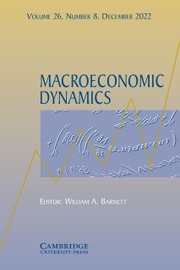No CrossRef data available.
Article contents
Revisiting risky money
Published online by Cambridge University Press: 02 April 2025
Abstract
Risk was incorporated into monetary aggregation over thirty-five years ago, using a stochastic version of the workhorse money-in-the-utility-function model. Nevertheless, the mathematical foundations of this stochastic model remain shaky. To firm the foundations, this paper employs richer probability concepts than Borel-measurability, enabling me to prove the existence of a well-behaved solution and to derive stochastic Euler equations. This measurability approach is less common in economics, possibly because the derivation of stochastic Euler equations is new. Importantly, the problem’s economics are not restricted by the approach. The results provide firm footing for the growing monetary aggregation under risk literature, which integrates monetary and finance theory. As crypto-currencies and stable coins garner attention, solidifying the foundations of risky money becomes more critical. The method also supports deriving stochastic Euler equations for any dynamic economics problem that features contemporaneous uncertainty about prices, including asset pricing models like capital asset pricing models and stochastic consumer choice models.
Keywords
- Type
- Articles
- Information
- Copyright
- © The Author(s), 2025. Published by Cambridge University Press


